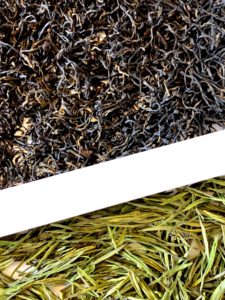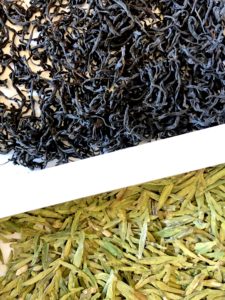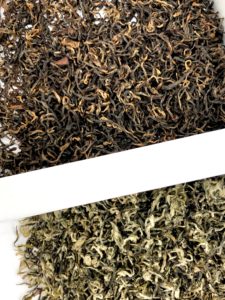
Black tea, or hongcha (lit. red tea) as it is known to the Chinese-speaking world, never quite hit the bigtime in its own homeland. That is, of course, until the meticulously-made and exorbitantly-priced Jin Jun Mei black tea showed up.
Seven Cups wrote about Jin Jun Mei and the ripples it sent through the Chinese tea market six years ago when Austin authored the blog post The Demise of Tongmu Lapsang Souchong. This post remains one of the highest-trafficked blogs on our site, so I feel it warrants an update, or maybe a sequel. As Austin described, the popularity of Jin Jun Mei significantly changed Tongmu tea making. Producers reoriented towards as much production of Jin Jun Mei as possible and true examples of the old Tongmu-grown smoked teas were pushed to the margins. This is the “demise” Austin wrote about.
There was a positive side of the Jin Jun Mei mania, however. Jin Jun Mei’s success in 2006 with an unheard-of-price tag proved that high-end black tea could demand serious money. In the years since, China’s tea market responded to that demand with nothing short of a hongcha renaissance.
Before the black tea renaissance
To appreciate the changes this renaissance brought, I’d like to first go back to describe the state of black tea in China in the early 2000’s, before Jin Jun Mei. The sense one got at the time was that black tea was either viewed as a regional oddity (when it was high-quality loose leaf tea) or a commodity style just made to suit the tastes of the international market.

We can see black tea’s marginal status in the 2001 edition of Zhongguo Chajing, a volume that stood as a corpus of knowledge on the overall Chinese tea industry when it was published. Within this book’s 675 pages, the editors devote a scant 18 pages to black tea. Compare that to the list of notable green teas which takes up nearly 100 pages in itself.
Similarly, in a sampling of commonly referenced “10 famous teas of China” lists published by the Chinese tea industry throughout the 20th century, you’ll see that black teas almost never made the cut, except for the occasional inclusion of Qimen.
Of course, there were regions with histories of black tea production that were well known to the Chinese tea world – among them Tongmu Guan in Wuyishan, Fujian province; Qimen County in Anhui; and Fengqing County in Yunnan. These regions produced respected black tea and still do today, although I recall the orientation was a bit different for most of these origins. The early 2000s is around the time when I first started paying close attention to Chinese teas, so I’ll offer my own impressions of these origins from that time.
Tea from Tongmu Guan, although respected for its history as the birthplace of black tea and for the purity of its products, was relatively low-price. Offerings from major producers were limited to traditionally leafy black tea with varying degrees of smoke and roughly made “qizhong” wulong, which I recall tasting like stemmy maocha for modern yancha.
Yunnanese black tea, or dianhong, excelled in commodity production, but much of the higher quality material in this era would get a better price if made into sheng or shu puer tea. I recall the difficulty of buying Dian Hong Jin Ya (Golden Buds) for a few years in the early 2000’s as the puer bubble inflated.
Qimen, however, was producing and promoting examples of black tea made with high-quality spring material. Qimen’s exceptional tea may have even been inspiration for tea makers in Tongmu Guan to create the bud-only Jin Jun Mei. In 2004 Seven Cups’ own Austin Hodge took a road trip up to Qimen county with Jiang Yuanxun and Liang Junde, two Tongmu teamakers who would soon invent the blockbuster Jin Jun Mei just a few years later in 2006.
Wherever the inspiration for Jin Jun Mei came from, it came at the right time. China’s market was in the midst of a rise of personal wealth, increasing tea consumer sophistication, concern over purity of products, and a strong culture of official gift giving. Moreover, high-priced tea was already in the national awareness with the puer bubble. Jin Jun Mei’s origins, craft, and price tag all spoke to the zeitgeist. By the end of the decade, Tongmu had again become the premier origin of black tea and really expensive black tea became a thing.
The rise of high-end Chinese black teas
By the mid-2010’s, tea makers all across China were chasing the popularity of top market black tea. New origins pushed out examples of fully-oxidized teas and they often used excellent spring leaf material from local tea bush varieties. For example, An Ji Bai Cha green tea producers developed An Ji Hong, a black tea made using Anji county’s albescent and amino acid-rich Bai Ye #1 variety. Similarly, in Chaozhou, tea makers used traditional dan cong wulong cultivars to craft fully-oxidized dan cong black tea. Even producers of extremely expensive and famous green teas like Bi Luo Chun and Shi Feng Long Jing, took the risk of making some of their valuable early spring leaves into black tea (marketed as Bi Luo Hong and Jiu Qu Hong Mei, respectively). In the times before, these origins would have used cheap summer leaf to make their black tea, if any at all.
The traditional origins of black tea were not resting on their laurels, either.

As Jin Jun Mei has been faked (or copied so much that it has become a style almost independent of origin), Tongmu black tea is now extremely productive. A flurry of Tongmu black teas boasting stylish proprietary names and innovative production techniques all appear to be vying to be the next Jin Jun Mei.
Qimen continued its tradition of excellent quality and embraced the high-end gift tea market with new products. In 2016, a retail boutique Qimen county was offering an ornate vessel filled with 100 grams of “National Gift” tea for 16000 RMB. If Jin Jun Mei copied high-end Qimen’s production standards, Qimen certainly took note and copied Jin Jun Mei’s price tag.
Yunnan’s dianhong has leveraged the popularity of both black teas and old-tree puer tea. Today, there are numerous examples of black tea made of highly-sought-after leaf material that would have been made into high-end sheng puer tea a decade ago. Lao Shu Dian Hong made from Camellia taliensis leaves instead of the traditional Camellia sinensis is a standout example.
Novelty is exciting to taste and stroke our chins over, but you may be inclined to ask “yes, but is all this new tea any good?” In some cases yes, in others no, but in general I’d observe that standard of high-end black tea has increased and will continue to increase in a self-perpetuating way as it responds to increasing consumer sophistication.
On the whole, the flavor of these emergent specialty black teas is orienting towards something new and distinctly Chinese. These newer teas often emphasize fruit, floral, and sweet spice aromas. They eschew the full-bodied tannic smack we expect from our tea bags of “English breakfast” tea in the west and instead, modern Chinese black tea is trending toward a softer, less chewy body with a pronounced returning sweetness. This a great example of a product that illustrates how Chinese tea is in fact very productive and responsive to trends and consumer tastes — a contradiction to the common packaging of high-end Chinese tea as an ancient, traditional, and conservative product.
This is the Chinese black tea renaissance. A new wave of innovation has elevated the prestige paid to black tea’s quality and provenance, and this has benefited black tea making in general. Even the traditional styles like Lapasang Souchong, which you can now buy from Tongmu teamakers, seems to be more beautifully made than ever before, even if it does have to share the stage with a line of new styles. It turns out this story isn’t about demise — it’s about rebirth.
References
Chen, Zonghan, ed. Zhongguochajing «中国茶经» Shanghai: Shanghai Wenhua Publishing Co., June 2001. Print. (ISBN 7-50511-499-4)
Special thanks to Eric Carr and Lizzie Miranda for help with the pictures accompanying this blog post.
